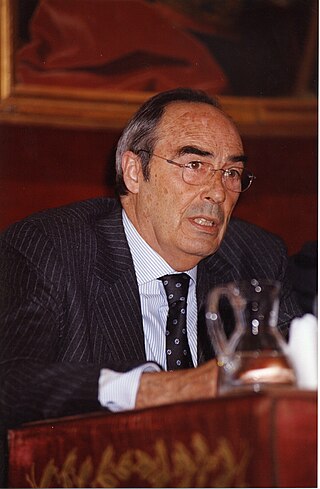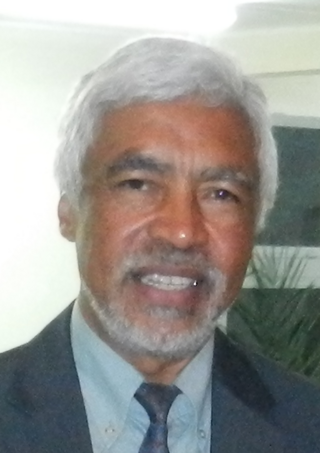Related Research Articles
String field theory (SFT) is a formalism in string theory in which the dynamics of relativistic strings is reformulated in the language of quantum field theory. This is accomplished at the level of perturbation theory by finding a collection of vertices for joining and splitting strings, as well as string propagators, that give a Feynman diagram-like expansion for string scattering amplitudes. In most string field theories, this expansion is encoded by a classical action found by second-quantizing the free string and adding interaction terms. As is usually the case in second quantization, a classical field configuration of the second-quantized theory is given by a wave function in the original theory. In the case of string field theory, this implies that a classical configuration, usually called the string field, is given by an element of the free string Fock space.
In string theory, a heterotic string is a closed string (or loop) which is a hybrid ('heterotic') of a superstring and a bosonic string. There are two kinds of heterotic string, the heterotic SO(32) and the heterotic E8 × E8, abbreviated to HO and HE. Heterotic string theory was first developed in 1985 by David Gross, Jeffrey Harvey, Emil Martinec, and Ryan Rohm (the so-called "Princeton string quartet"), in one of the key papers that fueled the first superstring revolution.
A conformal anomaly, scale anomaly, trace anomaly or Weyl anomaly is an anomaly, i.e. a quantum phenomenon that breaks the conformal symmetry of the classical theory.

A three-body force is a force that does not exist in a system of two objects but appears in a three-body system. In general, if the behaviour of a system of more than two objects cannot be described by the two-body interactions between all possible pairs, as a first approximation, the deviation is mainly due to a three-body force.
Emil John Martinec is an American string theorist, a physics professor at the Enrico Fermi Institute at the University of Chicago, and director of the Kadanoff Center for Theoretical Physics. He was part of a group at Princeton University that developed heterotic string theory in 1985.
In theoretical physics, a dual resonance model arose during the early investigation (1968–1973) of string theory as an S-matrix theory of the strong interaction.
Tamiaki Yoneya is a Japanese physicist.
In theoretical physics, boundary conformal field theory (BCFT) is a conformal field theory defined on a spacetime with a boundary. Different kinds of boundary conditions for the fields may be imposed on the fundamental fields; for example, Neumann boundary condition or Dirichlet boundary condition is acceptable for free bosonic fields. BCFT was developed by John Cardy.

Édouard Brézin is a French theoretical physicist. He is professor at Université Paris 6, working at the laboratory for theoretical physics (LPT) of the École Normale Supérieure since 1986.
Igor R. Klebanov is an American theoretical physicist. Since 1989, he has been a faculty member at Princeton University where he is currently a Eugene Higgins Professor of Physics and the Director of the Princeton Center for Theoretical Science. In 2016, he was elected to the National Academy of Sciences. Since 2022, he is the Director of the Simons Collaboration on Confinement and QCD Strings.
The history of string theory spans several decades of intense research including two superstring revolutions. Through the combined efforts of many researchers, string theory has developed into a broad and varied subject with connections to quantum gravity, particle and condensed matter physics, cosmology, and pure mathematics.

John (Jean) Iliopoulos is a Greek physicist. He is the first person to present the Standard Model of particle physics in a single report. He is best known for his prediction of the charm quark with Sheldon Glashow and Luciano Maiani. Iliopoulos is also known for demonstrating the cancellation of anomalies in the Standard model. He is further known for the Fayet-Iliopoulos D-term formula, which was introduced in 1974. He is currently an honorary member of Laboratory of theoretical physics of École Normale Supérieure, Paris.

Francisco José Ynduráin Muñoz was a Spanish theoretical physicist. He founded the particle physics research group that became the Department of Theoretical Physics at the Autonomous University of Madrid, where he was a Professor. He was described by his colleagues as "a scientist that always searched for excellence in research".

Xiao-Gang Wen is a Chinese-American physicist. He is a Cecil and Ida Green Professor of Physics at the Massachusetts Institute of Technology and Distinguished Visiting Research Chair at the Perimeter Institute for Theoretical Physics. His expertise is in condensed matter theory in strongly correlated electronic systems. In Oct. 2016, he was awarded the Oliver E. Buckley Condensed Matter Prize.

Anthony Ichiro Sanda is a Japanese-American particle physicist. Along with Ikaros Bigi, he was awarded the 2004 Sakurai Prize for his work on CP violation and B meson decays.
Erwin Gabathuler was a particle physicist from Northern Ireland.
Ryan Milton Rohm is an American string theorist. He is one of four physicists known as the Princeton string quartet, and is responsible for the development of heterotic string theory along with David Gross, Jeffrey A. Harvey and Emil Martinec, the other members of the Princeton String Quartet.

Stephan Narison is a Malagasy theoretical high-energy physicist specialized in quantum chromodynamics (QCD), the gauge theory of strong interactions. He is the founder of the Series of International Conferences in Quantum Chromodynamics (QCD-Montpellier) and of the Series of International Conferences in High-Energy Physics (HEPMAD-Madagascar).
Paul Stephen Aspinwall is a British theoretical physicist and mathematician, who works on string theory and also algebraic geometry.
The spectral dimension is a real-valued quantity that characterizes a spacetime geometry and topology. It characterizes a spread into space over time, e.g. a ink drop diffusing in a water glass or the evolution of a pandemic in a population. Its definition is as follow: if a phenomenon spreads as , with the time, then the spectral dimension is . The spectral dimension depends on the topology of the space, e.g., the distribution of neighbors in a population, and the diffusion rate.
References
- ↑ Gross, David J.; Harvey, Jeffrey A.; Martinec, Emil; Rohm, Ryan (1985-02-11). "Heterotic String". Physical Review Letters. American Physical Society (APS). 54 (6): 502–505. doi:10.1103/physrevlett.54.502. ISSN 0031-9007. PMID 10031535.
- ↑ Dennis Overbye (2004-12-07). "String theory, at 20, explains it all (or not)". The New York Times. Retrieved 2020-03-15.
- ↑ Jeff Harvey, University of Chicago. Candidate for General Councillor. Archived 2010-06-15 at the Wayback Machine American Physical Society. Accessed April 29, 2010